Hunting wild truffles in Mississippi means heading into humid pine woods, loamy creek bottoms, and hardwood hillsides with no guarantee of success. These underground fungi are notoriously difficult to locate, even in forests you think you know well.
Truffles are prized for their rich culinary potential, their rarity, and the hidden way they grow beneath the soil. Unlike surface mushrooms, they demand slow searching and careful digging, often guided more by instinct than sight.
Most people don’t realize Mississippi holds these kinds of fungal treasures, tucked away in terrain as varied as blackland prairies and oak-draped ravines. The real reward might not be how many you find, but the fact that you found any at all.
What We Cover In This Article:
- What Wild Truffles Look Like
- Truffle Lookalikes To Avoid
- Best Practices For Finding Truffles
- Where You Can Find Truffles Around The State
- Other Great Locations For Truffles
- When The Best Time Of The Year Is To Find Truffles
- The extensive local experience and understanding of our team
- Input from multiple local foragers and foraging groups
- The accessibility of the various locations
- Safety and potential hazards when collecting
- Private and public locations
- A desire to include locations for both experienced foragers and those who are just starting out
Using these weights we think we’ve put together the best list out there for just about any forager to be successful!
A Quick Reminder
Before we get into the specifics about where and how to find these plants and mushrooms, we want to be clear that before ingesting any wild plant or mushroom, it should be identified with 100% certainty as edible by someone qualified and experienced in mushroom and plant identification, such as a professional mycologist or an expert forager. Misidentification can lead to serious illness or death.
All plants and mushrooms have the potential to cause severe adverse reactions in certain individuals, even death. If you are consuming wild foragables, it is crucial to cook them thoroughly and properly and only eat a small portion to test for personal tolerance. Some people may have allergies or sensitivities to specific mushrooms and plants, even if they are considered safe for others.
The information provided in this article is for general informational and educational purposes only. Foraging involves inherent risks.
What Wild Truffles Look Like
The U.S. is home to several native truffle species that grow wild in forests across the country. Each one has its own unique scent, appearance, and preferred habitat. Here are the types of truffles you can find:
Oregon Black Truffles (Leucangium carthusianum)
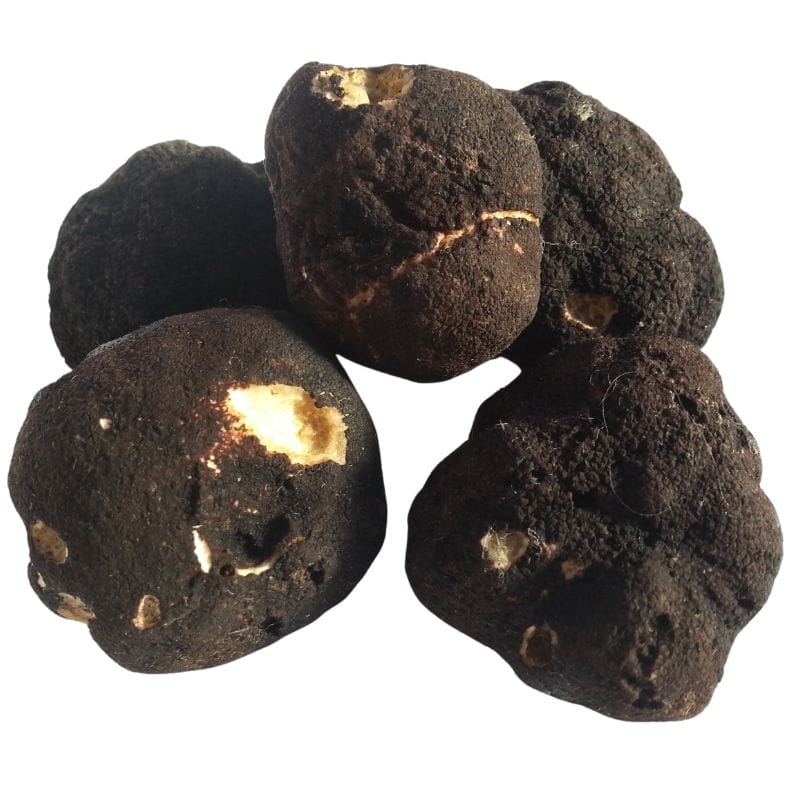
Leucangium carthusianum, also called the Oregon black truffle, grows in the Pacific Northwest and usually shows up around Douglas-fir trees. It’s a native species and one of the more well-known edible truffles from the region.
On the outside, it looks like a small lump of coal—dark black, kind of lumpy or warty, and sometimes slightly smoother in spots. They’re usually about the size of a golf ball, but they can be smaller or larger depending on the season.
Inside, the truffle is firm with a marbled pattern of gray and white veins running through it. When it’s fresh, it smells fruity, almost like pineapple, but the scent gets stronger and muskier as it ripens.
If you’re out looking for them, check in moist, shady forests with soft, loamy soil, especially where there’s a lot of moss or ferns. They grow just below the surface, so people often use trained dogs to help sniff out the ripe ones.
Compared to the Oregon white truffle, which is lighter in color and has a sharper, garlicky aroma, the black truffle has a deeper, more earthy smell. It’s also bigger and firmer than the southern U.S. truffles like Tuber lyonii, which tend to be smaller, paler, and grow around hardwoods like oaks and hickories.
Oregon Winter White Truffles (Tuber oregonense and Tuber gibbosum)
Oregon has two native white truffles that are starting to get more attention: the Oregon Winter White Truffle (Tuber oregonense) and the Oregon Spring White Truffle (Tuber gibbosum). They grow underground in forests and are prized for their strong, savory aroma.
From the outside, these truffles are small, roundish, and kind of bumpy, usually pale beige to light brown. Cut one open, and you’ll see a white interior that darkens with age, showing off a web of white veins when it’s fully mature.
The Winter White Truffle pops up from late fall into February, while the Spring White starts showing up around January and can last into June. They’re pretty similar, but the Winter variety is known for having a more powerful scent and flavor.
To find them, you’ll want to look in forests with younger Douglas-fir trees on the west side of the Cascades. Truffle hunters often check for loose soil or spots where animals have been scratching, which can be a sign there’s something below.
When fully ripe, both types give off a bold smell that’s often compared to garlic, cheese, or earthy spices. They’re usually served raw, shaved over dishes to add that truffle kick without losing any of the aroma.
Appalachian Truffle (Tuber canaliculatum)
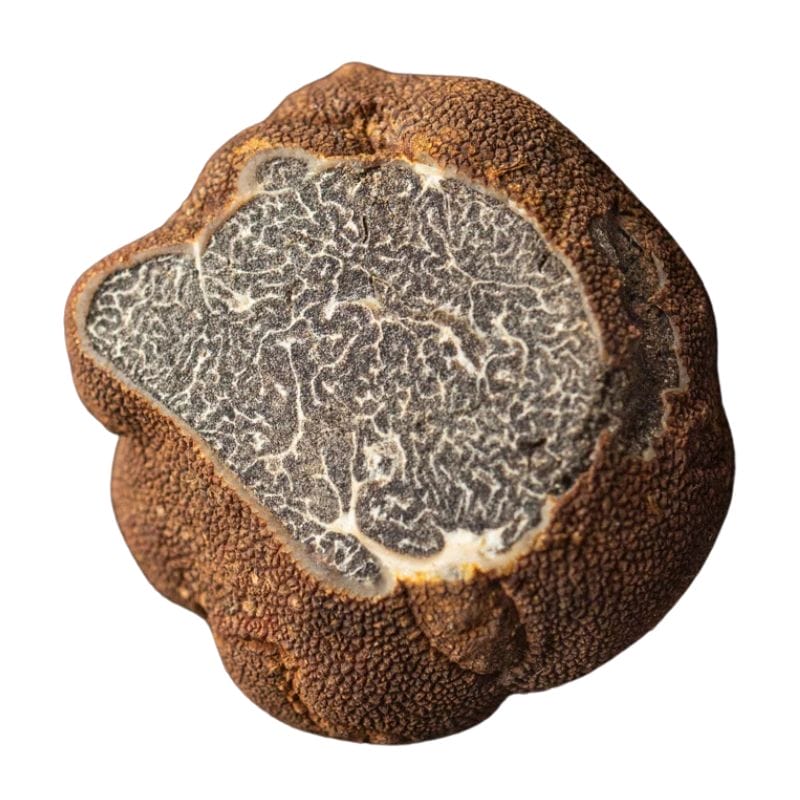
The Appalachian truffle, also known as Tuber canaliculatum, is a native North American truffle that’s slowly getting noticed. It’s about the size of a walnut and has a reddish-brown, bumpy outer surface that looks kind of like a rough, warty potato.
When you cut it open, the inside is firm and dark brown with thin white veins running through it like a marbled pattern. If it’s fully ripe, the smell is strong and earthy—some say it has a kind of nutty, funky aroma that stands out.
You can find these truffles in mixed hardwood forests, especially around oaks and pines, from late summer through fall. They grow underground, so look for spots where the soil is loose and animals like squirrels have been digging—sometimes that’s a good clue.
If you’re foraging, gently raking the top layer of soil near tree roots can help, but a trained dog or even a good nose makes it way easier. Once you know what to look for, the reddish color and bumpy skin are good signs you’ve found the right thing.
Compared to truffles like Tuber oregonense or Leucangium carthusianum, Tuber canaliculatum is more subtle in every way. Its smaller size and lighter scent mean you have to pay closer attention when foraging.
It’s also not as popular in the culinary world because it doesn’t pack the same punch in terms of flavor or aroma. Still, finding one can be rewarding, especially if you’re exploring different types of fungi in the area.
Desert Truffle (Terfezia and Tirmania spp.)
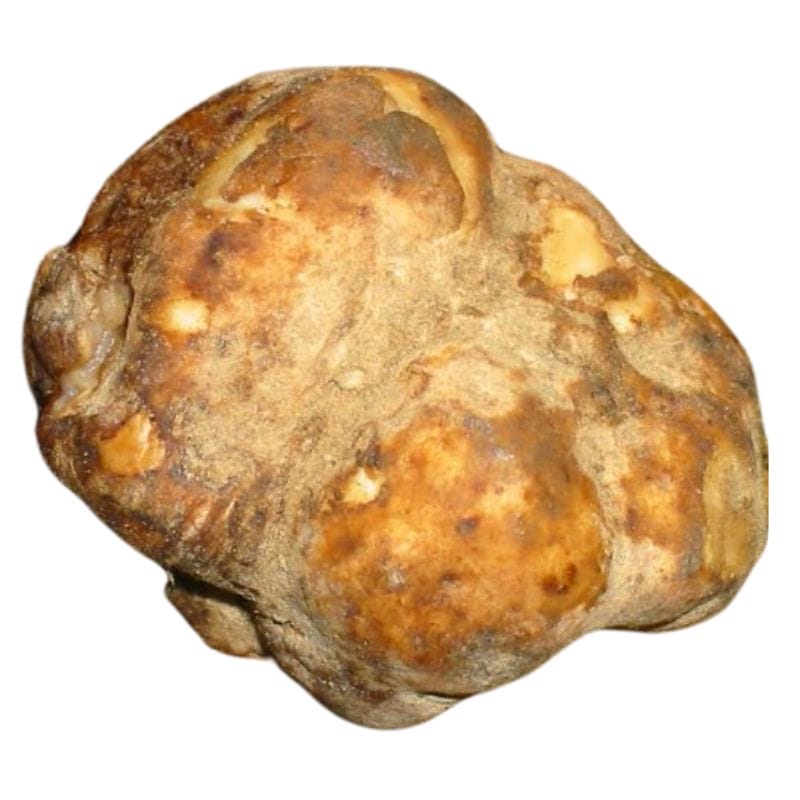
Terfezia and Tirmania are two types of truffles that are sometimes called desert truffles. These are a bit different from the truffles we usually think of, with their bold flavors and rich aromas.
These ones are a little more understated, but they’re fascinating in their own right. What makes them stand out is their ability to thrive in dry, harsh environments where you wouldn’t expect something so delicate to grow.
Unlike the earthy, intense aroma of black or white truffles, Terfezia and Tirmania truffles have a milder scent and flavor. They’re often described as nutty, with a hint of sweetness, but they lack the strong garlicky or musky notes you might associate with other truffles.
Their texture is also different—more firm and less oily than what you’d find with species like Tuber oregonense. They might not have the same culinary punch, but they’re still prized in traditional dishes, where their subtle flavors shine in simpler recipes.
When it comes to appearance, they’re easy to spot once you know what you’re looking for. They’re round to slightly irregular in shape, and their color can range from light beige to a reddish-brown, depending on the species.
The surface is usually smooth or slightly textured, without the rough, knobby look of a black truffle. Cut one open, and you’ll see a pale interior that’s often uniform in color, lacking the intricate veining you’d see in something like Leucangium carthusianum.
Pecan Truffle (Tuber lyonii)
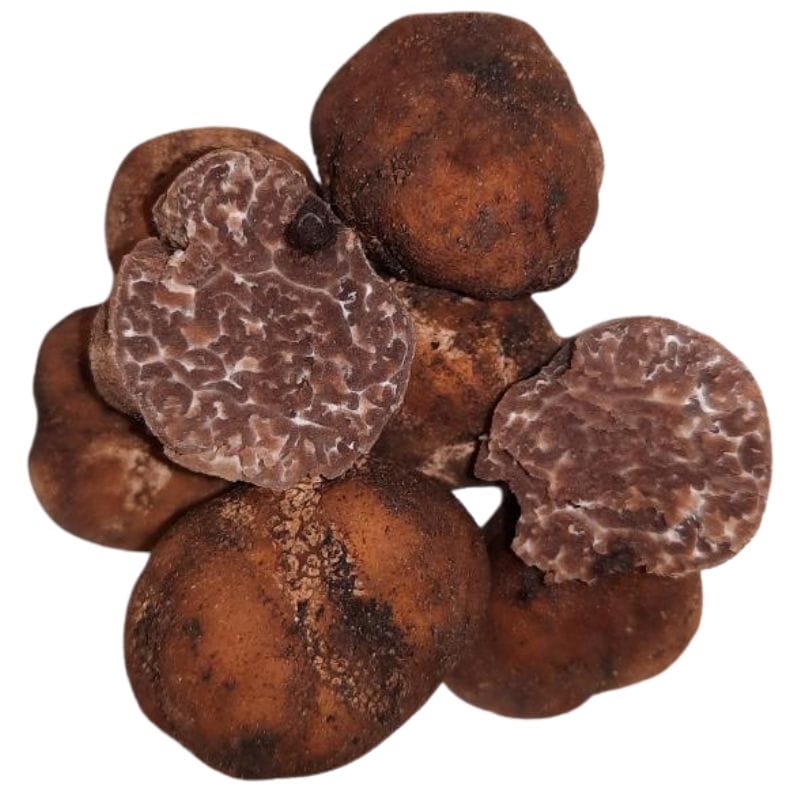
Tuber lyonii, also known as the pecan truffle, is a native North American truffle that grows underground near the roots of pecan trees. You’ll mostly find it in the southeastern U.S., especially in states like Texas, Georgia, and Mississippi.
On the outside, pecan truffles are round to lumpy and have a smooth, light brown skin that darkens as they age. They’re usually about the size of a marble or golf ball, and sometimes they even poke up slightly through the soil surface.
If you slice one open, the inside has a pretty marbled look—light tan streaks mixed with darker brown, almost like wood grain. The smell is earthy, nutty, and kind of warm, especially when they’re fully mature.
When you’re out looking for them, check under mature pecan trees or other hardwoods like oaks and hickories. Trained dogs can help sniff them out, but people sometimes spot them by looking for little cracks in the soil or raised areas near the tree’s base.
Compared to other U.S. truffles like the Oregon white truffle or the Appalachian black truffle, pecan truffles have a milder flavor and are more common in orchards. They’re a solid option in the kitchen—freshly sliced over pasta or mixed into butter—and they don’t come with the high price tag of their European cousins.
Truffle Lookalikes To Avoid
When you’re out hunting you also need to know about a few different fungi species that look very similar to the delicious truffles we’re after but are either inedible or not worth eating. Keep an eye out for:
Pine Truffles (Geopora cooperi)

Geopora cooperi is a fungus that can easily confuse someone new to truffle hunting. It’s sometimes called the pine truffle because it grows underground like a true truffle and often pops up near certain trees.
At first glance, it might seem like you’ve hit the jackpot, but this one is a false truffle, not something you’d want to eat or sell.
The easiest way to tell Geopora cooperi apart from real truffles is by looking closely at its structure. While true truffles have a smooth or slightly knobby exterior and a marbled interior, Geopora cooperi has a rougher, more irregular outer surface.
When it matures, it sometimes splits open, revealing a cup-like shape, which true truffles never do. Inside, it’s less dense and doesn’t have the intricate veining that makes real truffles so unique.
Another big difference is the smell. True truffles have a strong, rich aroma that’s earthy, sweet, or garlicky, depending on the species. Geopora cooperi, on the other hand, has a much weaker scent, and it’s not as pleasant or distinctive.
If you’re relying on aroma to identify your find, this one will give itself away pretty quickly. So, while it might look similar at first, a closer inspection will show it’s not the culinary treasure you’re hoping for.
Stinking Slime Truffle (Melanogaster ambiguus)
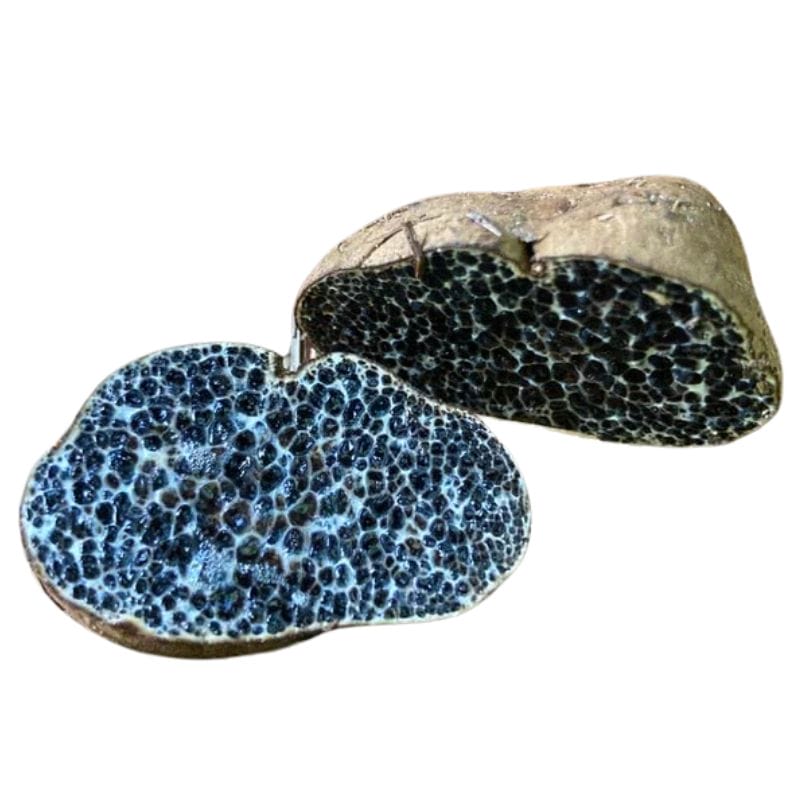
Melanogaster Ambiguus, because of their reddish-brown to dark brown exterior, might look like true truffles at first glance, but they’re quite different when you know what to look for.
The key difference is on the inside. When you cut open Melanogaster ambiguus, the interior is filled with flattened cells that have a shiny black gelatinous feel to them. Real truffles, on the other hand, have those beautiful marbled veins running through their flesh, almost like a web.
Another giveaway is the smell. While real truffles have a rich, earthy aroma that’s mouthwatering, Melanogaster ambiguus tends to have a much stronger, almost unpleasant odor—it’s not something you’d want to sprinkle on your pasta.
Earthballs (Scleroderma)
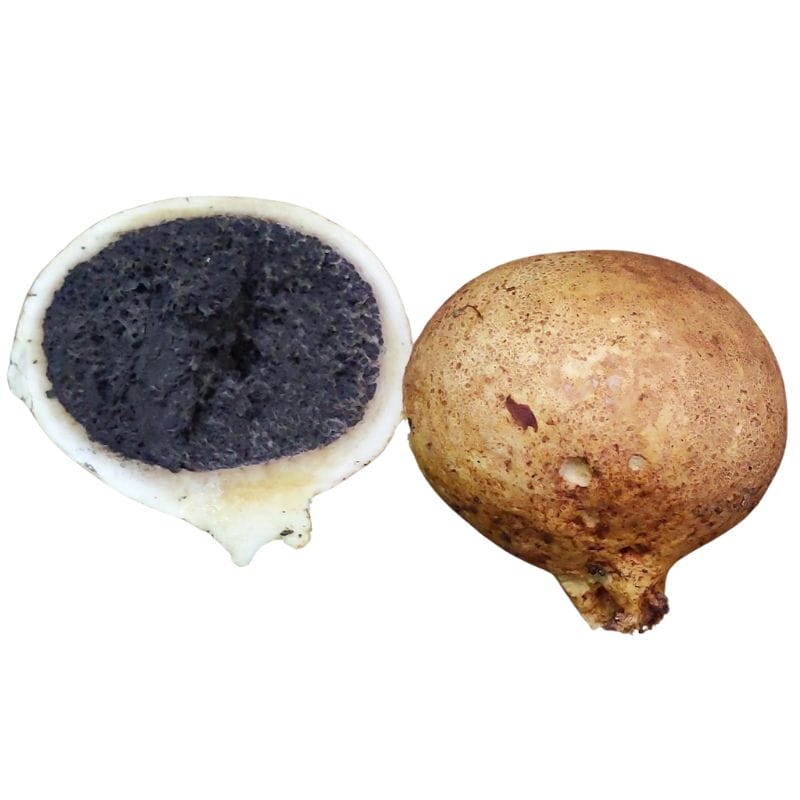
Scleroderma, commonly called earthballs, can easily fool someone who’s just starting out because they grow underground and have a round shape similar to truffles. But don’t be tricked—Scleroderma is not a true truffle, and it’s actually toxic, so it’s important to know how to tell the difference.
The first thing you’ll notice is the outer skin, which is thicker and tougher than that of most truffles. It can range in color from yellowish to dark brown, often with a rough or cracked texture.
If you cut it open, the difference becomes even clearer. While true truffles have a marbled interior with delicate white veins, Scleroderma starts out with a whitish inside that quickly darkens as it matures, turning black or purple with no marbling. It’s dense and solid, almost like charcoal in the later stages.
Another big giveaway is the smell. True truffles have a rich, earthy aroma that makes them so prized, while Scleroderma has little to no pleasant scent—some even describe it as musty or unpleasant.
Deer Truffles (Elaphomyces)
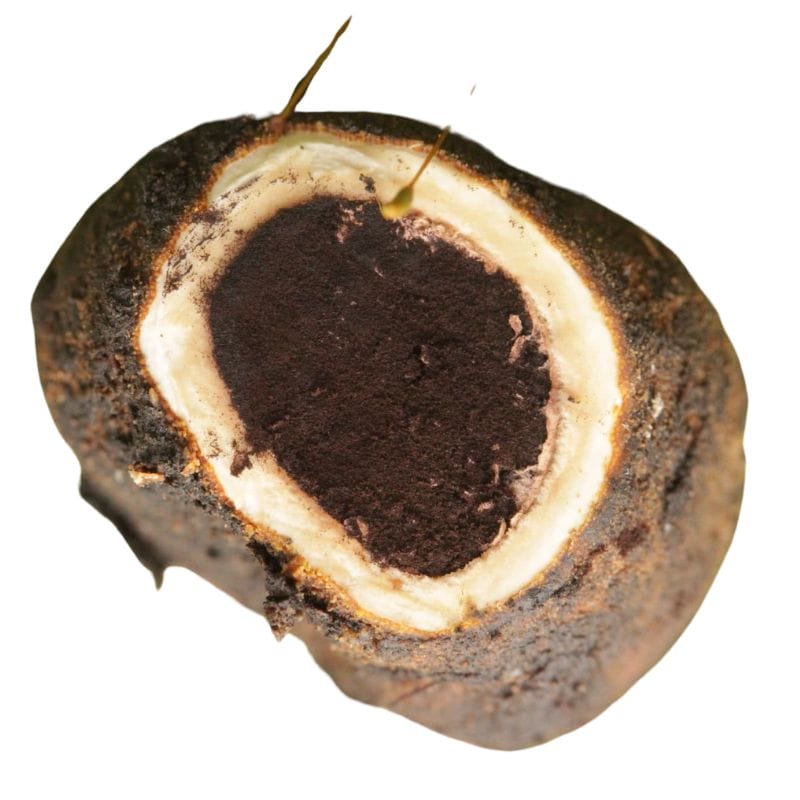
Elaphomyces, also known as deer truffles, look like true truffles at first glance, but they’re a whole different story. They’re called deer truffles because wildlife, especially deer and rodents, love to eat them. For us humans, though, they’re not edible—and definitely not what you want to mistake for a prized truffle.
Here’s how you can tell Elaphomyces apart from the real thing. First, they have a tough, warty outer surface that can range from pale tan to black, depending on the species and their age.
When you cut them open, the inside is solid and sometimes speckled or marbled, but not in the delicate, vein-like pattern you’d see in true truffles.
Their smell is also a big giveaway. Instead of the rich, earthy aroma of an edible truffle, Elaphomyces either has little scent or an odor that’s earthy but not particularly appealing.
Another thing to know is that Elaphomyces often grows deeper in the soil than true truffles, and they tend to have a harder, woodier texture.
Best Practices For Finding Truffles
Truffle hunting can be a rewarding adventure if you know the right tips and tricks. Here’s what you should keep in mind to improve your chances of finding these underground treasures:
Wait 10 to 14 Days After Heavy Rain
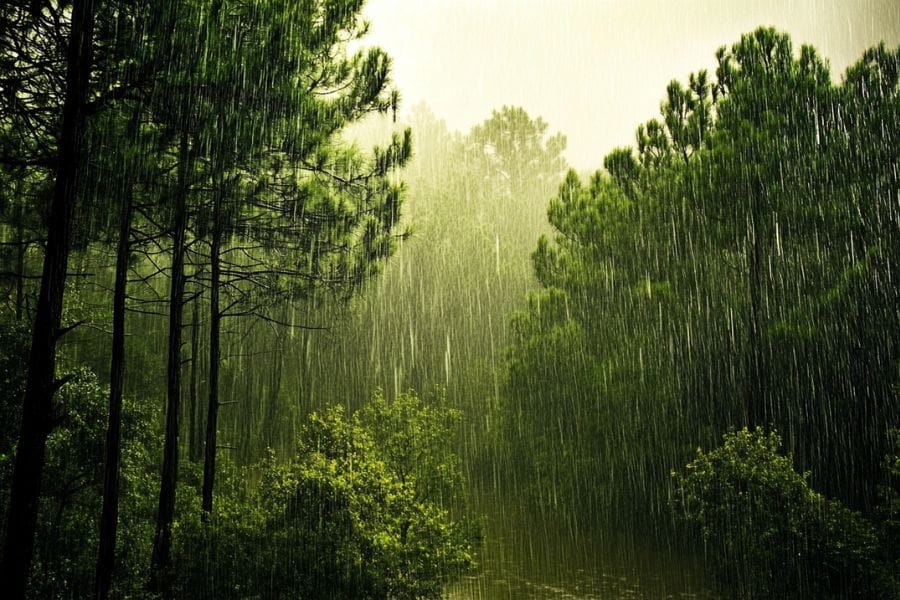
After a heavy rain, it’s best to wait about 10 to 14 days before heading out. This gives the truffles time to mature and release their signature aroma, making it easier for you (and your dog) to sniff them out. Rain helps truffles grow, but they don’t start giving off their scent right away.
As the soil warms up, the truffles get more aromatic, and the ground becomes looser, which makes digging easier without disturbing the environment too much. The timing is perfect to find truffles at their best—both in quality and in how easy they are to locate.
Find the Right Trees
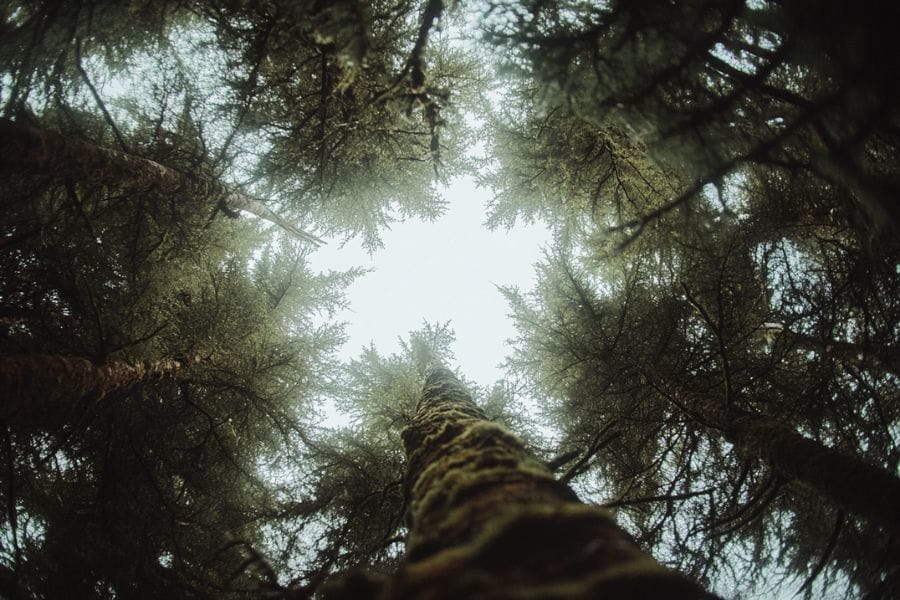
Truffles don’t grow just anywhere—they have a special relationship with certain trees. You won’t find them under just any tree, so knowing which ones to look for can make all the difference. Some of the best trees to look out for are:
- Pines
- Douglas-firs
- Oaks
- Hazelnuts
- Cypresses
- Willows
For example, if you’re looking for Oregon white truffles, keep an eye out for Douglas-fir trees. California black truffles, on the other hand, are often found near oaks and hazelnuts. The soil around these trees also needs to be slightly alkaline, so it helps to know what kind of ground you’re walking on as well.
Watch for Wildlife Activity
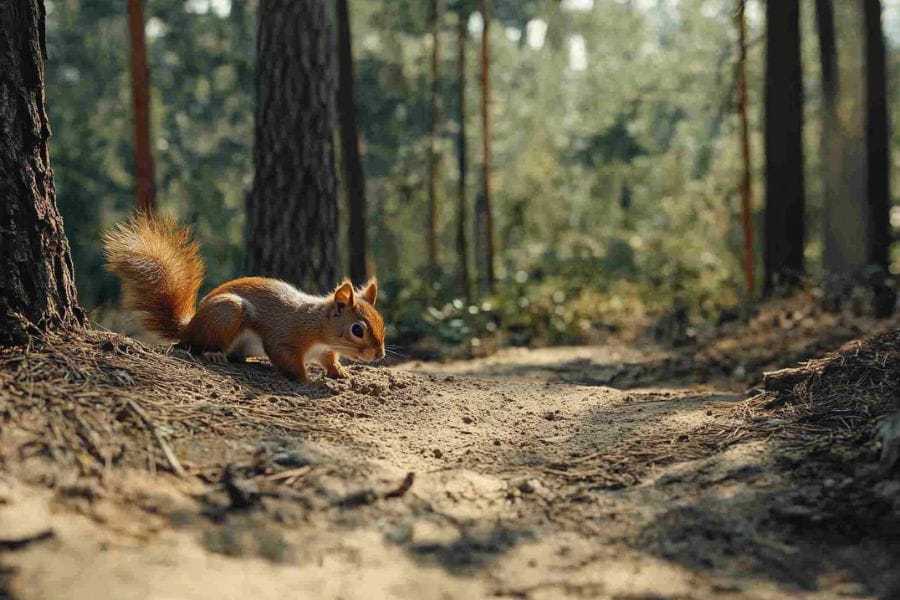
Animals like squirrels and chipmunks often help spread truffle spores, and sometimes their digging can lead you straight to truffles. While you won’t always find truffles in every pit animals dig (they also look for things like acorns or bulbs), fresh digs are a good clue. The more recent the pit, the better chance it has of leading to truffles.
Even though animals are a part of the truffle cycle, most hunters prefer using dogs to find the real treasure underground. Dogs have an incredible nose for truffles and can pinpoint their location much more reliably than any squirrel or chipmunk.
Get a Little Help from a Truffle-Hunting Dog
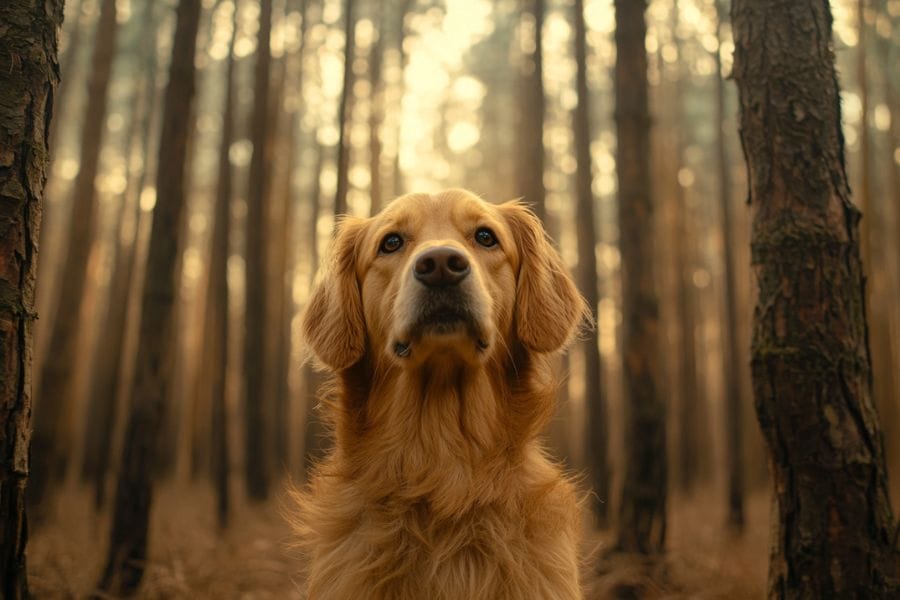
If you’re serious about truffle hunting, a trained dog can make your life a whole lot easier. Their sense of smell is extraordinary, and they’re trained to find mature truffles buried beneath the surface. Many truffle hunters swear by their dogs, and for good reason—they’re much more accurate than humans when it comes to sniffing out truffles.
If you don’t already have a trained dog, you can connect with local foraging groups or specialized trainers who offer truffle-hunting services. Some places even host events where you can see experienced handlers with their dogs in action. And if you’re feeling adventurous, you can train your own dog using truffle-scent kits and practice in a controlled space before hitting the woods.
Before you head out
Before embarking on any foraging activities, it is essential to understand and follow local laws and guidelines. Always confirm that you have permission to access any land and obtain permission from landowners if you are foraging on private property. Trespassing or foraging without permission is illegal and disrespectful.
For public lands, familiarize yourself with the foraging regulations, as some areas may restrict or prohibit the collection of mushrooms or other wild foods. These regulations and laws are frequently changing so always verify them before heading out to hunt. What we have listed below may be out of date and inaccurate as a result.
Where You Can Find Truffles Around The State
Now we’re going to go over five of the best locations for finding truffles. We’ll go a bit in-depth here and then provide a much longer list of other spots to try.
Holly Springs National Forest

Holly Springs National Forest covers over 155,000 acres in north Mississippi. The forest floor here is rich with decaying leaves that create perfect soil conditions for truffles to grow. This national forest is known for its mixture of hardwood and pine trees that form partnerships with underground fungi.
Most successful truffle hunters focus on the older sections of the forest where trees have had decades to develop relationships with fungi. Look around the bases of mature oak trees, especially in areas with gentle slopes where water drains but soil stays moist. The northeastern part of the forest has fewer visitors, giving truffles a chance to grow undisturbed.
Bring a small rake and gently scrape away the top layer of soil when searching. Many people have found black truffles here after rainy periods when the forest floor is soft and fragrant.
Homochitto National Forest
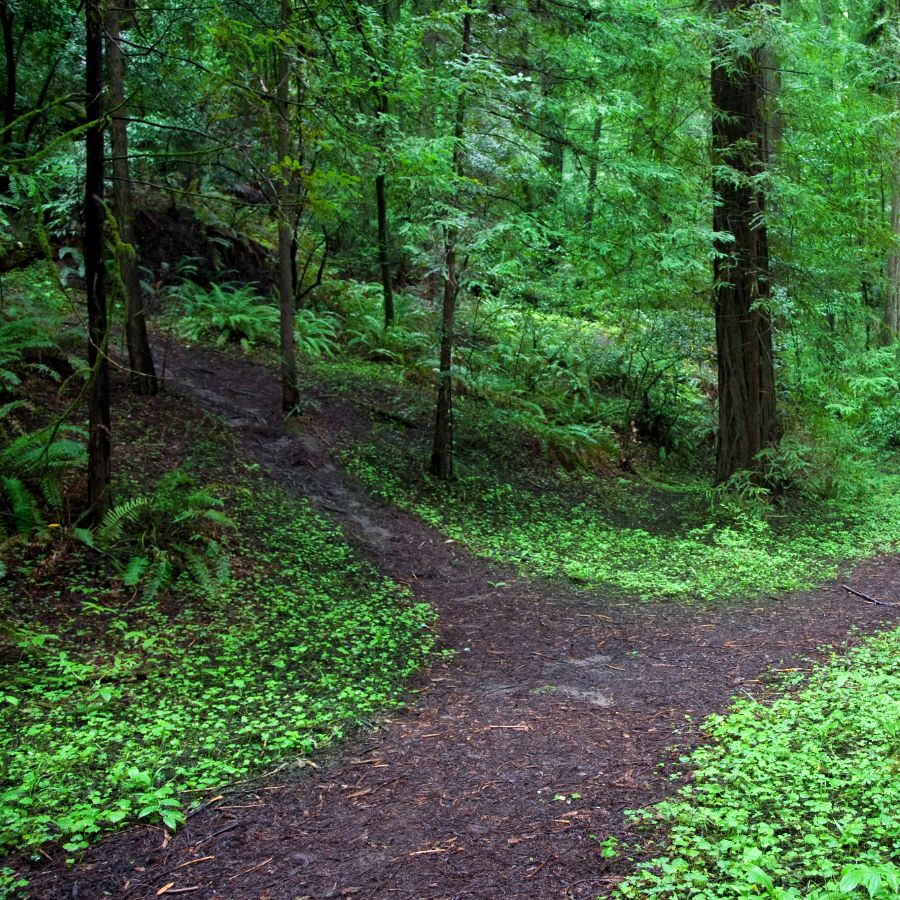
The beautiful Homochitto National Forest is located in southwest Mississippi. This 192,000-acre forest gets its name from a Native American word meaning “big red river.” The diverse terrain here creates many small enviroments where different truffle species can thrive.
The Clear Springs Recreation Area has proven to be a hotspot for truffle hunters who venture away from the main trails. The mix of beech and hickory trees in this forest forms special underground connections with truffle fungi.
Search in areas with a mix of sunlight and shade rather than deep in the darkest parts of the forest. The soil here has a good mix of clay and sand that truffles seem to prefer. Remember to fill in any holes you dig so other forest visitors can enjoy the natural beauty too.
Tombigbee National Forest

Covering about 67,000 acres in eastern Mississippi, Tombigbee National Forest offers excellent truffle hunting grounds. The soil here is slightly acidic and well-drained, creating ideal conditions for truffle development.
Truffle hunters should explore the areas around Choctaw Lake where stands of older oak trees create perfect truffle habitat. The forest’s rolling hills create natural drainage patterns that maintain just the right amount of soil moisture. After warm days following rain, the conditions become perfect for finding these underground treasures.
Another promising area is near Davis Lake where the combination of tree species and soil type seems to favor truffle growth. Try looking in transition zones where forest meets clearing, as some truffle species prefer these edge habitats.
The varied terrain of Tombigbee means you can find different truffle types depending on where you search.
De Soto National Forest

De Soto National Forest is the largest national forest in Mississippi, spanning over 500,000 acres in the southern part of the state. The forest’s unique sandy soil mixed with decaying plant matter creates a special environment where truffles flourish.
Unlike other forests, De Soto features a rare longleaf pine ecosystem alongside scattered hardwood stands.
The Black Creek Wilderness area is particularly promising because it has minimal human disturbance. Many successful truffle hunters focus on areas with gentle slopes where water doesn’t stand after rain.
The Airey Lake Recreation Area also has good potential with its mix of oak trees growing in well-drained soil. Local experts suggest looking after several days of warm weather following a rainy period.
Bienville National Forest

Located in central Mississippi, Bienville National Forest spans approximately 178,000 acres of diverse woodland. The forest features a mix of planted pines and natural hardwood areas that create varied habitats for fungi growth. Bienville’s soil composition has the perfect balance that truffles need to develop properly.
Marathon Lake area has proven fruitful for many truffle hunters due to its mature oak trees. These trees form special underground relationships with truffle fungi that benefit both organisms. The forest floor in these areas often has a thick layer of decomposing leaves that feeds the developing truffles.
Another good hunting ground is near Shockaloo Trail, where older trees have established fungal networks. Look for areas with limited foot traffic where the soil remains undisturbed for long periods.
Some local foragers have reported finding both summer and winter truffle varieties in this forest depending on weather conditions and time of year.
Other Great Locations For Truffles
Northern Mississippi
| Location | Collection Guidelines |
|---|---|
| Chickasaw State Park | Truffle foraging allowed in wooded areas off designated trails. |
| Holly Springs National Forest | Personal collection of wild fungi permitted in non-restricted forest zones. |
| John W. Kyle State Park | Truffle hunting allowed near oak groves on undeveloped land. |
| J.P. Coleman State Park | You may forage in wooded sections near the river bluff trails. |
| Kirkwood National Wildlife Management Area | Collection permitted along forest floor, away from game-managed zones. |
| Natchez Trace Parkway (Tishomingo Section) | Non-commercial collection allowed near nature trail areas. |
| Sardis Waterfowl WMA | Gathering of truffles allowed in tree-dense upland zones. |
| Tombigbee National Forest | Wild fungi collection permitted in forested areas with foot access. |
| Trace State Park | Truffle collection allowed near old oak and beech stands. |
Central Mississippi
| Location | Collection Guidelines |
|---|---|
| Bienville National Forest | Non-commercial truffle gathering permitted under hardwood cover. |
| Carver Point WMA | Foraging permitted away from hunting plots and access roads. |
| Golden Memorial State Park | Collection allowed in forest edges and leaf-littered areas. |
| Holmes County State Park | You can search near picnic and trail-side wooded areas. |
| Leake County Public Lands | Scattered hardwoods here support limited truffle foraging. |
| Leroy Percy State Park | Allowed in pine-hardwood mix areas off the main trails. |
| Madison County Wildlife Refuge | Personal use foraging permitted in forested habitat zones. |
| Pearl River Wildlife Management Area | Truffle collection permitted along bottomland hardwood paths. |
| Roosevelt State Park | Forage along nature trail edges with mature trees. |
Southern Mississippi
| Location | Collection Guidelines |
|---|---|
| Airey Lake Recreation Area | Truffle hunting allowed near oak groves and along leaf beds. |
| Biloxi River State Forest | Collection permitted in upland oak areas and damp forest soil. |
| Camp Shelby WMA | Limited public access zones allow non-commercial foraging. |
| Chickasawhay Ranger District (De Soto NF) | Truffle collection allowed off-trail in hardwood areas. |
| Clarkco State Park | Permitted in wooded zones near the walking paths. |
| De Soto National Forest | Open forest floor access allows wild mushroom foraging. |
| Flint Creek Water Park | Allowed in old-growth hardwood patches near waterline. |
| George County WMA | Collection allowed in upland tracts with oak and hickory. |
| Grand Bay National Estuarine Research Reserve | Limited upland hardwoods allow seasonal truffle gathering. |
| Marion County WMA | Foraging allowed in specific public hunting forest tracts. |
| Mississippi Sandhill Crane NWR (Public Access Zones) | Truffle foraging allowed in designated trail-accessible areas. |
| Paul B. Johnson State Park | Oak-rich wooded sections open for personal use collection. |
| Red Creek WMA | Permitted in non-hunting seasons in hardwood forest areas. |
| Shepard State Park | You may collect near creekside woodlands and old trails. |
| Stone County Public Forest Lands | Allowed in leaf-litter areas near public footpaths. |
Delta Region (West Mississippi)
| Location | Collection Guidelines |
|---|---|
| Dahomey National Wildlife Refuge | Foraging allowed in accessible hardwood forest sections. |
| Delta National Forest | Personal truffle collection permitted in oak-dominated zones. |
| Lake Washington Wildlife Area | Allowed along dense tree lines and moist forest patches. |
| Mahannah WMA | Truffle foraging allowed in woodland near seasonal wetlands. |
| Panther Swamp National Wildlife Refuge | Collection permitted in limited upland hardwood areas. |
| Yazoo National Wildlife Refuge | Public access zones permit collection beneath oak canopies. |
When The Best Time Of The Year Is To Find Truffles
In Mississippi, the prime truffle hunting season runs from late November through early March. This winter window offers the perfect combination of cool soil temperatures and adequate moisture that triggers truffle fruiting.
December and January are particularly productive months when soil temperatures hover between 45-55°F. Black truffles typically mature earlier in the season, while white varieties often peak in February.
The timing also varies by location within the state. Northern Mississippi forests often see truffles emerge 2-3 weeks later than southern forests due to temperature differences.
Watch for subtle signs that indicate prime hunting time. When oak leaves have mostly fallen and decomposed slightly, the forest floor is usually ready. Successful hunters often report that periods following several light frosts but before hard freezes yield the most flavorful finds.
One Final Disclaimer
The information provided in this article is for general informational and educational purposes only. Foraging for wild plants and mushrooms involves inherent risks. Some wild plants and mushrooms are toxic and can be easily mistaken for edible varieties.
Before ingesting anything, it should be identified with 100% certainty as edible by someone qualified and experienced in mushroom and plant identification, such as a professional mycologist or an expert forager. Misidentification can lead to serious illness or death.
All mushrooms and plants have the potential to cause severe adverse reactions in certain individuals, even death. If you are consuming foraged items, it is crucial to cook them thoroughly and properly and only eat a small portion to test for personal tolerance. Some people may have allergies or sensitivities to specific mushrooms and plants, even if they are considered safe for others.
Foraged items should always be fully cooked with proper instructions to ensure they are safe to eat. Many wild mushrooms and plants contain toxins and compounds that can be harmful if ingested.


